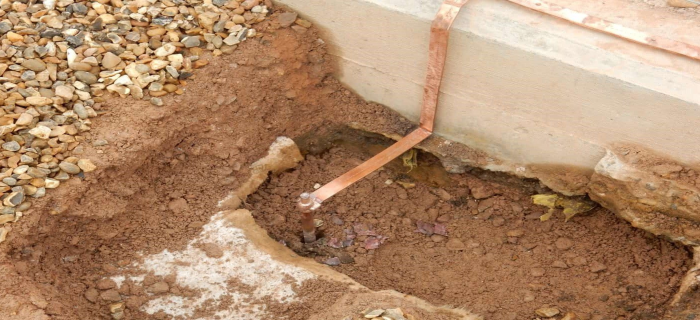
Earthing: OVERCOMING CHALLENGES IN EARTHING FOR LARGE-SCALE ELECTRICAL INSTALLATIONS
14 Sep 2023
Earthing, also known as grounding, is a crucial concept in the electrical industry and plays a significant role in ensuring safety, equipment protection, and the proper functioning of electrical systems. It involves connecting electrical equipment and installations to the earth or a conducting body that serves as a reference potential. The earth or grounding point is typically a large conductive surface, such as a metal rod driven into the ground or a grounding grid buried below the surface.
Creating an Earthing System
Effective earthing system design necessitates careful consideration of various variables, including soil resistivity, safety concerns, and current carrying capacity. To ensure the safety and reliability of electrical installations, regular inspection, testing, repair, and replacement of earthing components are essential. By taking these proactive measures, potential hazards can be mitigated, and the integrity of the electrical systems can be preserved, fostering a secure environment for all stakeholders involved.
Continual Check-ups and Maintenance
The performance and safety of the earthing system must be maintained by routine testing and inspection. Testing earthing systems is necessary to make sure they have the necessary resistance and that the conductors and electrodes are free from fractures and other problems. To find any corrosion or damage to the earthing system components, regular checks should be done. For the earthing system to remain safe and functional, it is crucial to repair or replace any components that show signs of damage during inspection or testing. These risks can be avoided with proper earthing system maintenance, which also guarantees the electrical installation is operating securely and effectively. The earthing system’s lifespan can be increased with routine maintenance, requiring fewer expensive repairs or replacements.
The primary purposes of earthing in the electrical industry are as follows Electrical Safety:
The most critical aspect of earthing is to protect people and equipment from electrical shock. In case of a fault, such as a short circuit, stray current or lightning strike, the excessive current is safely directed to the earth rather than flowing through a person or sensitive equipment.
Fault Current Dissipation:
Earthing provides a low-resistance path for fault currents to flow away from the electrical system. By doing so, it helps prevent damage to the elewctrical equipment and minimizes the risk of fire hazards.
Equipment Protection: Proper earthing helps in protecting electrical equipment from transient overvoltages, such as surges caused by lightning or switching events. It ensures that any excess voltage is directed to the ground, safeguarding the equipment.
Electromagnetic Interference (EMI) Mitigation:
Earthing can reduce electromagnetic interference, which may cause disruptions in sensitive electronic systems, by providing a reference point for the unwanted currents.
Earthing: Goal
By earthing, one can avoid electrocution and fires brought on by the earth leaking electricity through an unfavourable channel and causing the potential of a current-carrying conductor to rise over that of the intended insulation. Static charge accumulates on metal parts of electrical equipment when they come into contact with live wires, which can happen when the wiring is placed incorrectly or the cable insulation is broken. When a human touches a charged metal, they get shocked.
There are various earthing techniques for electrical systems. The system’s neutral and the ground, or earth, are directly connected via GI (galvanised iron) wire. Neutral earthing or system earthing are two terms for this type of earthing. This type of earthing only occurs in systems with star winding. Access to earthing equipment is available to electrical appliances. The conducting wire is used to ground electrical equipment parts like the metal frame that do not produce electricity. The most efficient and economical way of earthing is pipe earthing. 38mm-diameter, 2-meter-long pipes are buried vertically in the ground to produce earth electrodes.
A copper or GI earthing plate must be buried more than three metres below the surface as part of plate earthing process. This earthing plate is shielded by an alternative layer of coke and salts. Strip earthing is a practise used in gearbox processes. An electrode’s cross-section should be 25mm x 1.6mm for copper or 25mm x 4mm for GI or steel when it is set in a horizontal trench that is at least 0.5 metres deep.
Benefits of grounding: earthing
• Earthing will shield the employees from any injury in the event of a short circuit.
• Earthing still provides the simplest path for short-circuit current to travel even if the insulation fails.
• Equipment and humans are protected from lightning and high voltage surges via earthing.
• Metal can be used in electrical systems without being tested for conductivity if it is earthed properly.
Earthing: Components of the infrastructure for earthing
The following are the primary parts of an allinclusive electrical earthing system:
Earth Continuity Conductor
Earthing Lead
Earth Electrode
The part of the earthing system known as the “earth wire” or “earth continuity conductor” connects all the metals in an electrical installation, including the conduit, ducts, boxes, metallic switches, distribution boards, switches, fuses, regulating and controlling devices, metals in electrical machines like motors, generators, and transformers, as well as the metal framework in which electrical devices and components are installed.
Installation
Electrical installation is a critical process encompassing the meticulous setup, maintenance, and restoration of electrical components, equipment, and systems within various structures, commercial establishments, and facilities. This comprehensive scope encompasses diverse elements, such as electrical wiring, panels, lighting systems, power outlets, HVAC systems, and vital electrical machinery like engines, generators, and transformers. However, among these aspects, the design and implementation of an earthing system take precedence as one of the most pivotal components in electrical installations. An earthing system, also commonly referred to as a grounding system, is an interconnected network of wires and electrodes deliberately engineered to establish a secure and efficient pathway for electrical faults to dissipate harmlessly into the ground. By providing an effective route for electrical defects, such as lightning strikes, power surges, or other electrical failures, the earthing safeguards electrical equipment and structures from potential damage. Thus, ensuring a well-designed and properly maintained earthing system is of paramount importance to establish a foundation for safe and reliable electrical systems.
Lastly, the meticulous and professional execution of electrical installation, with due emphasis on a well-thought-out earthing system, plays an indispensable role in upholding the safety and dependability of electrical setups in diverse applications. Proper design and regular upkeep of the earthing system are imperative to mitigate risks associated with electrical faults and ensure the smooth functioning and longevity of electrical equipment and installations. Neutral earthing versus equipment earthing (grounding)
The act of physically connecting an appliance’s outside shell to an earth zero voltage potential is known as equipment earthing. This shields the device’s internal circuitry from the environment outside electrically.
Equipment earthing guarantees that any current that would hurt its user is instead sent to the ground, which is essential for user safety. As a result, the person operating the gadget won’t be harmed if an internal problem or short circuit causes the phase (or live) wire to come into contact with the device’s case. Additionally, even if the circuit breaker will be triggered by the excessive current flowing through the appliance, earthing is still important because it’s possible that it won’t turn off the power before someone approaches the appliance.
In that it guards against unintentional electrocution, neutral earthing, often known as grounding, is comparable to equipment earthing. However, it connects the neutral wire directly to the earthing terminal rather than the unpowered casing of the appliance to the earth. Through allowing excess voltage to dissipate into the earth, this primarily to prevent an electrical overload.
Market for Earthing Equipment 2023
The global Earthing Equipment Market research offers valuable insights to businesses seeking to comprehend the market landscape across competitive applications, including the Construction Industry, Manufacturing Sector, Power Industry, Telecom, and Data Centre Industry. Additionally, the report presents an in-depth analysis of the market trends pertaining to various types of Earthing Equipment, namely Galvanised Grounding Rods, Copper Plated Grounding Rods,Graphite Grounding Rods, and Stainless Steel Ground Rods. By amalgamating data and findings from diverse sources, this comprehensive report provides a holistic view of the Earthing Equipment Market, enabling businesses to make informed decisions and stay abreast of the dynamic market conditions. Pentair (Erico), ABB, Schneider Electric, Nehring Electrical Works, A. N. Wallis, Galvan Electrical, GE Eaton, Harger Lightning and Grounding, Kingsmill Industries, INGESCO, Kopell Grounding System, Gmax Electric The Earthing Equipment Market Report’s major highlights include:
The global Earthing Equipment market demonstrated a noteworthy valuation of USD 4.7 billion in 2022 and is projected to achieve a commendable Compound Annual Growth Rate (CAGR) of 6.30% from 2023 to 2030, reaching USD 7.2 billion by 2030. This growth trajectory signifies increasing demand and promising opportunities within the industry. The market’s leading segment, CI flat, highlights the prominence of Copper-Bonded Ground Rods with flat tops, driving substantial sales and adoption. Notably, the Residential category is expected to witness the highest CAGR during the forecast period, driven by urbanization, housing development, and infrastructure advancements. North America plays a pivotal role in driving market growth, propelled by infrastructure development, modernization initiatives, and technological advancements.
Europe exhibits noteworthy adoption rates, and the Asia Pacific region is poised to emerge as the fastest-growing market, driven by infrastructure projects, telecommunication network developments, and industrialization. Augmented government expenditure in infrastructure and ongoing telecommunication network expansion are the primary growth drivers. However, challenges such as high initial investment and slow in certain sectors may impact potential buyers, while opportunities lie in renewable energy expansion and smart grid implementation, calling for advanced earthing solutions to ensure safety and optimal performance. Overall, the Earthing Equipment market presents a positive outlook, fueled by increasing government focus on infrastructure development and the proliferation of telecommunication networks worldwide. The varieties of earthing equipment on the market today
The market is divided into the following categories based on the product types that, in 2023, accounted for the biggest market share for earthing equipment.
• Galvanized Grounding Rod
• Copper Plated Grounding Rod
• Graphite Grounding Rod
• Stainless Steel Ground Rods
• Solid Copper Ground Rods
Market drivers and restraints for earthing equipment include
The study provides valuable insights into the raw materials essential for the Earthing Equipment industry, delving into the dynamics of the supply chain and production costs. Furthermore, it thoroughly assesses the impact of COVID-19 on the sector and offers recommendations on how companies can adapt to the evolving market dynamics. The research paper also highlights significant market constraints, such as commercial barriers and economic limitations in emerging nations. By being aware of these risks and challenges, businesses can proactively devise strategies to mitigate them and achieve longterm success in this captivating and ever-evolving sector. Understanding and addressing these factors will enable companies to navigate the complexities of the market, seize opportunities, and sustain growth in a resilient manner.
In conclusion, the earthing system is an indispensable component of electrical installations, playing a crucial role in ensuring safety and reliability. Proper earthing design, taking into account variables such as soil resistivity, safety considerations, and current carrying capability, is essential to provide an efficient pathway for electrical faults to dissipate harmlessly into the ground. Regular inspection, testing, repair, and replacement of earthing system components are vital to maintain its effectiveness and protect electrical equipment and structures from potential damage caused by electrical defects.
As companies navigate the shifting market dynamics, it is essential to adapt to the challenges and uncertainties presented by commercial market barriers and economic limitations in emerging nations. By being proactive in addressing these risks and difficulties, businesses can develop strategies to mitigate their impact and pave theway for long-term success in this fascinating and dynamic sector. Embracing innovation, staying abreast of industry trends, and maintaining a keen awareness of market demands will enable businesses to thrive in the ever-changing landscape of earthing equipment installations while contributing to the growth of the overall market size.



leave your comment